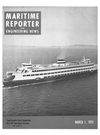
Page 4: of Maritime Reporter Magazine (March 1973)
Read this page in Pdf, Flash or Html5 edition of March 1973 Maritime Reporter Magazine
Powered by General Motors Electro Motive Division 8,500-hp diesels driving Coolidge propel- lers, the double-ended Spokane Had to go through two complete trial tests—once for each end. $9-Million Queen Of Washington Ferry Service
The Super-Ferry Spokane
Built By Todd Shipyards Corporation Seattle Division, The Spokane
And Her Sister Ship Walla Walla Are Each Capable Of Carrying 206 Cars And More Than 2,000 Passengers At Speeds Up To 20 Knots
The new. super-ferry Spokane, a 440-foot $9-million queen of the
Washington ferry system, and be- lieved to .be the world's largest and fastest double-ended ferry ever built, has just been completed by
Todd Seattle.
The Spokane is the epitome of luxury, a unique feature in a vessel usually noted for a strictly utilitar- ian, if not spartan, design. From the colorful exterior to the lavish, ultramodern interior, the Spokane is designed to attract the eye, and the tourist.
The new ferry is equipped with a propeller and rudder at each end, and is powered by 8,500-hp diesel engines. She is capable of carrying 206 cars and more than 2,000 pas- sengers at speeds up to 20 knots.
She is 58 feet longer and carries 46 more cars than the present Hyak class now in service.
Her sea trials consisted of a ma- jor mile run which included some 15 runs at various speeds near
Vashon Island, and other tests in the Point Wilson area of the Straits of Juan de Fuca. According to
Todd's trial operators, some 100 men who participated in the runs on each trip and who have logged trial miles on Puget Sound on a myriad of vessels, the trial run of this double-ender had its unusual aspects. As Todd's chief trials en- gineer George Gilreath pointed out, unlike other trials in conventional ships, the various tests for the
Spokane had to be conducted twice: once for each end, to make sure that both ends are seaworthy.
Specifications and designs of the two new ferries were handled by
Philip F. Spaulding & Associates (now Nickum & Spaulding Associ- ates, Inc.), naval architects and en- gineers of Seattle. To meet re- quirements of the Coast Guard, the new ferries feature complete drain- age, fuel oil, lubricating oil, fire- fighting, and freshwater systems.
Safety, heating, and ventilation were, of course, other design con- siderations.
Construction specifications called for hulls of welded-steel construc- tion and transverse frames with a complete innerbottom fitted through the area 'below the main engine room. Main engine founda- tions form an integral part of each (Continued next page)
The main car deck, showing the traffic lanes. On the partial gallery deck are casing and the side curtain plating. Vehicles are loaded and unloaded from four more passenger-auto lanes, two on each side, between the outboard engine each end of the gallery deck through the inclined ramp to the main deck. 6 Maritime Reporter/Engineering News

 3
3

 5
5
